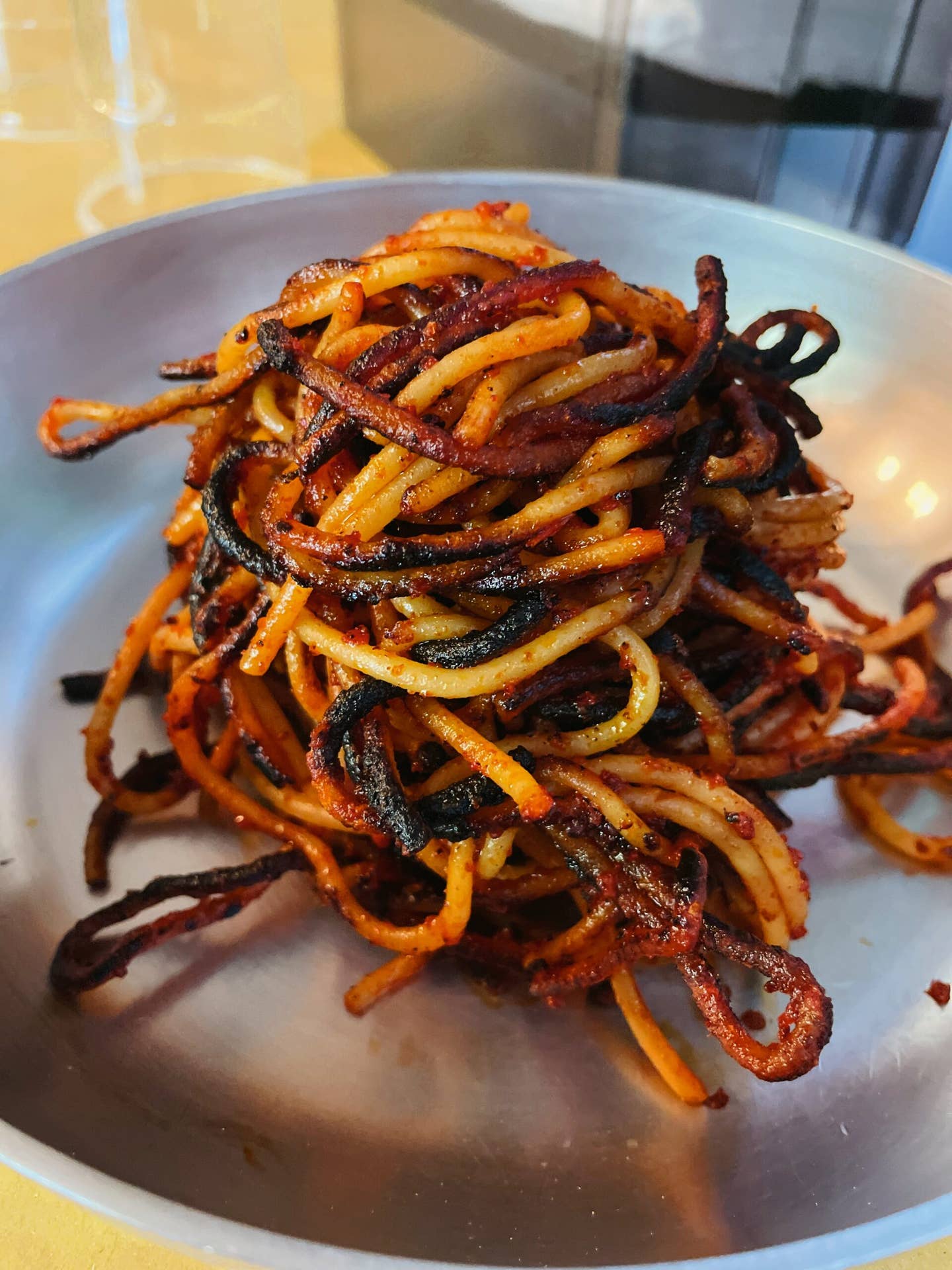The Origins of Spaghetti all’Assassina, the Pasta That Breaks All the Rules
A cookbook author digs into the history behind this regional Italian specialty that went from total obscurity to viral sensation.

It’s rare that you can pinpoint the time and place a pasta dish was invented—most of pasta history is the stuff of legend and folklore. But in the early 1960s, in the southern Italian region of Puglia, in the coastal city of Bari, at a restaurant called Al Sorso Preferito, spaghetti all’assassina—“assassin’s spaghetti”—was born.
In August 2022, I go to Al Sorso Preferito, where I meet the 80-year-old chef Pietro Lonigro, one of the inventors of the dish.
Chef Pietro tells me it happened by accident—and it didn’t exactly start with him. He began working at the restaurant at age 14, running errands and learning to cook from the restaurant’s then-owner, Vincenzo Francavilla. Chef Vincenzo often cooked a standard dish of spaghetti with tomatoes and dried chili peppers. But one time, it burned a bit on the bottom. Usually they would have thrown the pasta out, but instead the chefs ate it. And they were surprised to find that they actually liked those crunchy burnt bits, using one of my favorite Italian words to describe them—croccante, meaning “crunchy.” The word even sounds crunchy.
They started serving this crunchy new pasta to customers, who asked them to punch it up: more crunch, more spice, even a little more char. (By the way, the name comes from the dish’s spice—it was called spaghetti all’assassina even before the accidental burning. On my visit I found it to be hot by Italian standards but barely medium to my palate overall.) Chef Pietro says that when he eventually bought the restaurant in 1974, he kept riffing on the dish. He added the technique of rotating the pasta in the pan to char more of it, which also had the effect of further reducing the sauce into a sticky tomato paste. Eventually he settled on the spaghetti all’assassina he serves today.
For decades, the dish remained a little-known Barese specialty, served in only a few restaurants in Bari. About a decade ago, the secret started to get out, thanks to a guy named Massimo Dell’Erba—a physicist by day and passionate eater and home cook by night. In 2013, Massimo organized a dinner with a few friends at a local restaurant. Even though spaghetti all’assassina was not on the menu at this particular spot, he begged them to make it, and they did. “It was an amazing evening,” he told me when we met at Al Sorso Preferito.
The next morning, inspired, Massimo created a Facebook group and named it Accademia dell’Assassina—Academy of the Assassin. Their mission was to taste the dish at all the restaurants in Bari that served it, with a rigorous scoring system that rated each version on crunch, spice, and char. They published their results online.
Within months, the Facebook group had hundreds of members, each with a different opinion about who in Bari makes the best spaghetti all’assassina, how crunchy and spicy it should be, and perhaps most contentious of all: whether the spaghetti should be raw or partially boiled before it’s fried in the pan with the sauce. Chef Pietro insists on briefly boiling the pasta first because he says otherwise it burns too much in the pan. Others prefer the increased char and crunch that they say comes from skipping the boiling.
When Massimo leads me into the kitchen at Al Sorso Preferito to talk to Chef Pietro and watch the chefs there make the dish, all of these issues continue to provoke strong debate (in Italian) between Massimo, Pietro, and the other chefs. At one point I turn to my friend Antonello, my guide for the day, and ask what they’re arguing about. “They’re fighting about everything!” he replies. (I guess in Italian pasta culture, even the guy who INVENTED a dish can be accused of doing it wrong.)
Today, thanks to the influence of social media and the work of Massimo’s academy, which he started as a joke, “there is not a restaurant in Bari that doesn’t make the assassina,” he tells me. “A lot of them have invented their version,” including a popular variation made with broccoli rabe instead of tomato sauce, and another done with stracciatella cheese, the tender, spreadable insides of a ball of burrata.
So spaghetti all’assassina is a perfect example of how, even in Italian cuisine, people continue to come up with new ideas. Because that’s what people in kitchens do.
Recipe
Excerpted from the book Anything’s Pastable by Dan Pashman. Copyright © 2024 by Dan Pashman. Reprinted by permission of HarperCollins Publishers.
Keep Reading
Continue to Next Story










